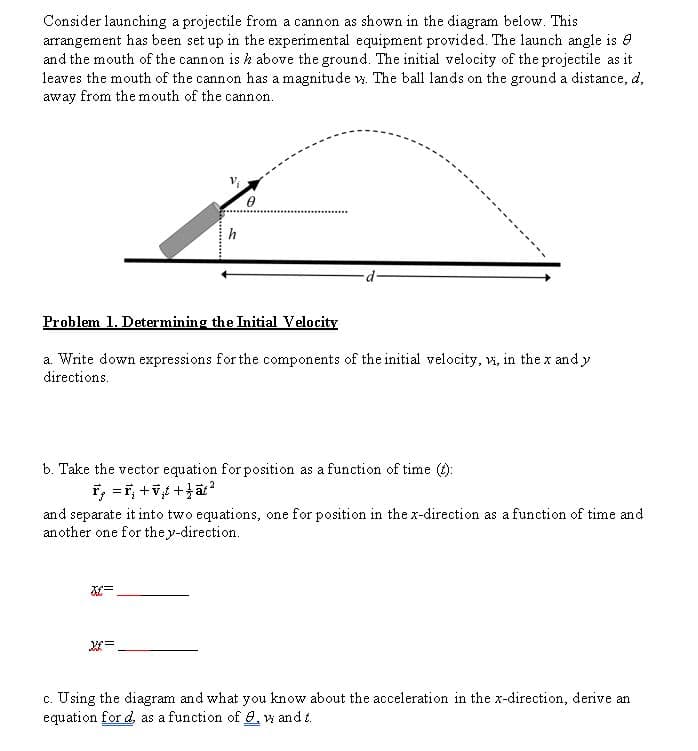Consider launching a projectile from a cannon as shown in the diagram below. This arrangement has been set up in the experimental equipment provided. The launch angle is e and the mouth of the cannon is h above the ground. The initial velocity of the projectile as it leaves the mouth of the cannon has a magnitude w. The ball lands on the ground a distance, d, away from the mouth of the cannon. d- Problem 1. Determining the Initial Velocity a. Write down expressions for the components of the initial velocity, , in the x and y directions. b. Take the vector equation for position as a function of time (): i, =f, +v + āt? and separate it into two equations, one for position in the x-direction as a function of time and an other one for they-direction. c. Using the diagram and what you know about the acceleration in the x-direction, derive an equation for d, as a function of 8, w and t.
Consider launching a projectile from a cannon as shown in the diagram below. This arrangement has been set up in the experimental equipment provided. The launch angle is e and the mouth of the cannon is h above the ground. The initial velocity of the projectile as it leaves the mouth of the cannon has a magnitude w. The ball lands on the ground a distance, d, away from the mouth of the cannon. d- Problem 1. Determining the Initial Velocity a. Write down expressions for the components of the initial velocity, , in the x and y directions. b. Take the vector equation for position as a function of time (): i, =f, +v + āt? and separate it into two equations, one for position in the x-direction as a function of time and an other one for they-direction. c. Using the diagram and what you know about the acceleration in the x-direction, derive an equation for d, as a function of 8, w and t.
University Physics Volume 1
18th Edition
ISBN:9781938168277
Author:William Moebs, Samuel J. Ling, Jeff Sanny
Publisher:William Moebs, Samuel J. Ling, Jeff Sanny
Chapter2: Vectors
Section: Chapter Questions
Problem 2.1CYU: Check Your Understanding Two motorboats named Alice and Bob are moving on a lake. Given the...
Related questions
Question
the first three parts

Transcribed Image Text:Consider launching a projectile from a cannon as shown in the diagram below. This
arrangement has been set up in the experimental equipment provided. The launch angle is e
and the mouth of the cannon is h above the ground. The initial velocity of the projectile as it
leaves the mouth of the cannon has a magnitude w. The ball lands on the ground a distance, d,
away from the mouth of the cannon.
d-
Problem 1. Determining the Initial Velocity
a. Write down expressions for the components of the initial velocity, , in the x and y
directions.
b. Take the vector equation for position as a function of time ():
and separate it into two equations, one for position in the x-direction as a function of time and
another one for they-direction.
c. Using the diagram and what you know about the acceleration in the x-direction, derive an
equation for d, as a function of 8, w and t.
Expert Solution
This question has been solved!
Explore an expertly crafted, step-by-step solution for a thorough understanding of key concepts.
Step by step
Solved in 4 steps with 1 images

Knowledge Booster
Learn more about
Need a deep-dive on the concept behind this application? Look no further. Learn more about this topic, physics and related others by exploring similar questions and additional content below.Recommended textbooks for you

University Physics Volume 1
Physics
ISBN:
9781938168277
Author:
William Moebs, Samuel J. Ling, Jeff Sanny
Publisher:
OpenStax - Rice University

Glencoe Physics: Principles and Problems, Student…
Physics
ISBN:
9780078807213
Author:
Paul W. Zitzewitz
Publisher:
Glencoe/McGraw-Hill

Physics for Scientists and Engineers: Foundations…
Physics
ISBN:
9781133939146
Author:
Katz, Debora M.
Publisher:
Cengage Learning

University Physics Volume 1
Physics
ISBN:
9781938168277
Author:
William Moebs, Samuel J. Ling, Jeff Sanny
Publisher:
OpenStax - Rice University

Glencoe Physics: Principles and Problems, Student…
Physics
ISBN:
9780078807213
Author:
Paul W. Zitzewitz
Publisher:
Glencoe/McGraw-Hill

Physics for Scientists and Engineers: Foundations…
Physics
ISBN:
9781133939146
Author:
Katz, Debora M.
Publisher:
Cengage Learning

Principles of Physics: A Calculus-Based Text
Physics
ISBN:
9781133104261
Author:
Raymond A. Serway, John W. Jewett
Publisher:
Cengage Learning